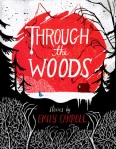 Through the Woods
Through the Woods
Emily Carroll
I have a…complicated relationship with the horror genre. For most of my life, I avoided it entirely, more afraid of the fear and uncertainty that would come as a result of the scary thing than the scary thing itself. But I loved those books and movies that existed right on the edge of horror–Frankenstein and Dracula were just creepy enough to satisfy my desire for something mildly frightening, but weren’t so scary that I found it difficult to sleep at night.
Through the Woods is something different. I’ve certainly watched and read scarier stories (in the won’t-sleep-without-a-light-on sense), and it’s true that Carroll’s comics didn’t terrify me in the ways that I expect from most horror. Instead, it filled me with a deep and intense sense of dread, and the suspicion that if I were to shift my attention from the book for just a moment, something once familiar would reveal its true form. Every story in this collection made me distrust my surroundings and everything I thought to be safe.
Many of the stories in Through the Woods deal with this distrust and reevaluation of the familiar and comfortable, but my favorite is a comic called “The Nesting Place.” It begins with Bell, a teenager visiting her brother and his new fiancee. At first, Rebecca seems friendly and eager, but something about her puts Bell on the defensive. After an accident leaves Bell bedridden, she discovers that Rebecca is not who she claims to be–she’s not even human, and hasn’t been for some time. She is a host for a creature from the woods that seeks to procreate and use Bell as a host for her offspring. Bell manages to trick the monster, and escapes with her brother into the city. But during the drive there, she discovers that her brother has already been possessed by the same creature that stole Rebecca’s body when she was a girl.
The story ends with this discovery, and the reader is left with Bell’s combined terror and heartbreak over the loss of her only remaining family. I think it’s this mixture of emotions that made this particular story stick. If she can’t trust her family, who can she trust? Where do we go when our safe places are compromised?
I first encountered Carroll’s work online where I read the story “His Face All Red.” What immediately struck me is that in this and many of Carroll’s other comics, we never discover what kind of monster is tormenting the characters, or if it is even a monster at all. Each story in Through the Woods ends on the precipice of revelation, with the suggestion that there are forces behind these events that we don’t understand. Like much of the horror genre, Carroll’s works operate on a symbolic level as well, and many of the supernatural elements can be explained away by any number of psychological phenomena: hallucinations, paranoia, delirium, etc.
Yet this doesn’t diminish these stories or lessen the fear that they inspire, because it ultimately forces us to choose what we will believe: that sinister creatures lurk in familiar places, or that our own minds and senses can so easily deceive us. Either way, you have to ask yourself: What can I truly trust?
Want to read this post on a site that isn’t Shelf Talker? Sure, whatever.